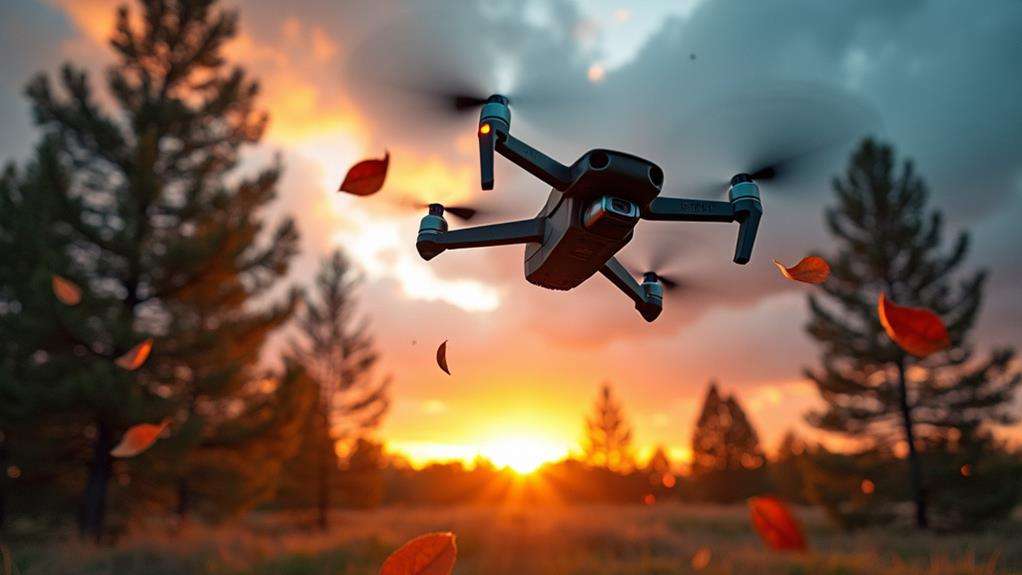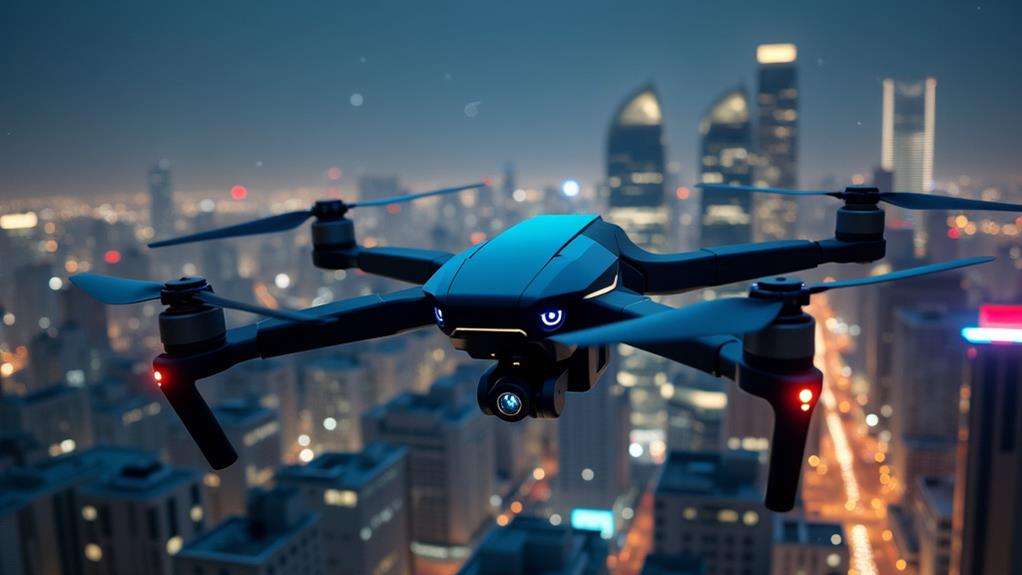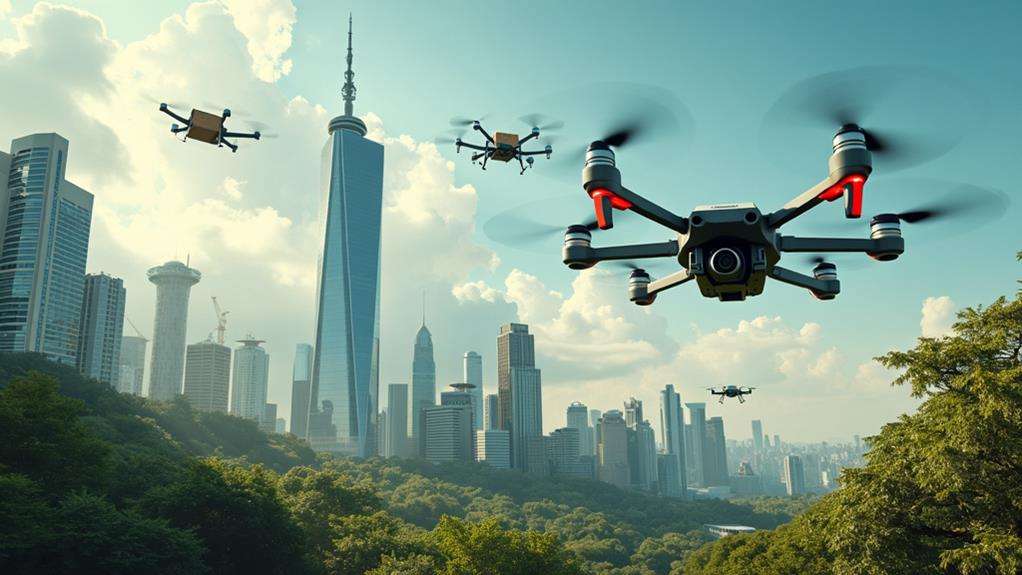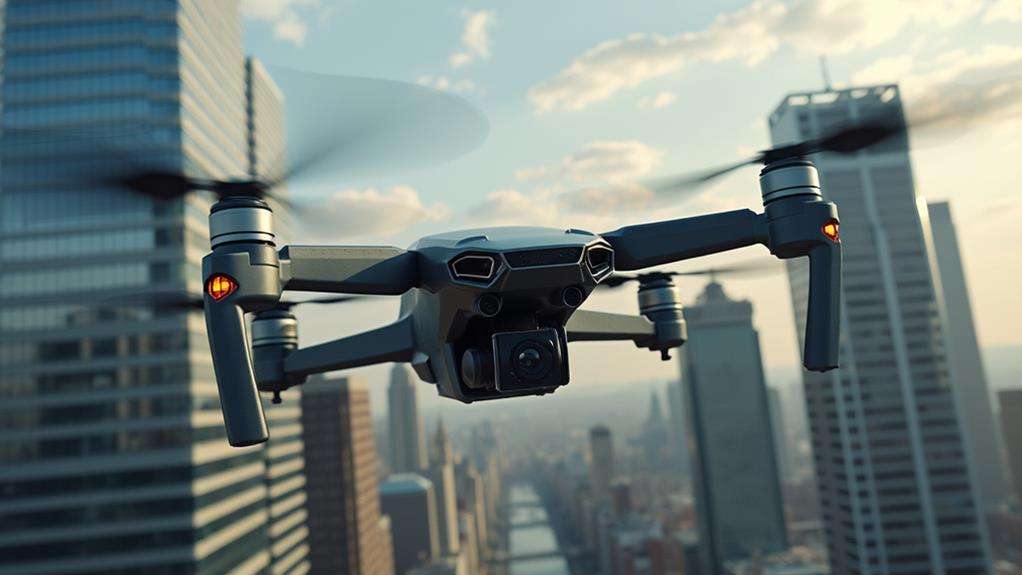What Is the Wind Rating for Drones?
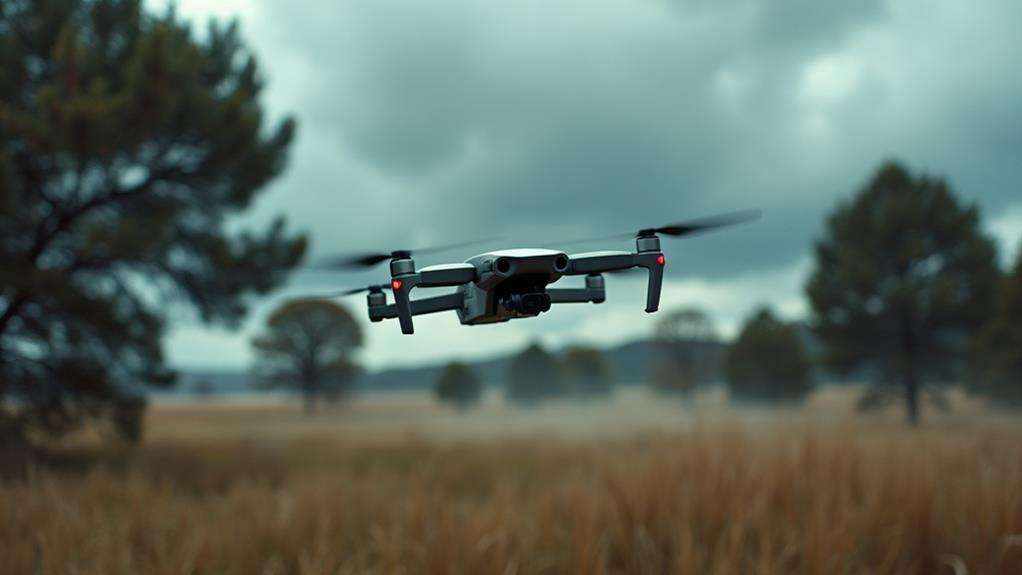
Understanding the wind rating of your drone is essential for safety and optimal performance. Most consumer drones have wind resistance ratings between 10-15 m/s. But what do these numbers mean for your flight experience? Knowing this can help you decide whether it's safe to launch or if you should wait for calmer conditions. Have you ever wondered how these ratings are determined and what factors might affect them? There are several considerations, including best practices for flying in windy conditions and the future advancements in wind resistance technology for drones.
Importance of Wind Ratings
Understanding the importance of wind ratings is crucial for anyone operating a drone. Wind ratings indicate the maximum wind speed a drone can handle, ensuring you can make informed decisions about when to fly. For instance, a drone like the DJI Mini 4 Pro has a wind resistance rating of 10.7 m/s (approximately 23.9 mph). This rating helps you gauge whether it's safe to fly in current weather conditions or if high winds make it too risky.
Knowing your drone's wind ratings is essential for maintaining control and stability during flight. Operating beyond the rated wind resistance can lead to instability or even crashes, jeopardizing your equipment and safety. Higher wind resistance levels correlate with better stability and control, allowing for a smoother and more successful drone operation, even in challenging weather.
Wind Resistance Scale
Understanding the wind resistance scale for drones is essential for ensuring flight stability in various wind conditions. Drones are rated based on their ability to handle specific wind speeds, with most consumer models capable of managing up to 34 mph. Testing your drone's wind resistance is crucial for safe and efficient operation in different weather scenarios.
Wind Speed Classes
Navigating the skies with a drone requires an understanding of wind speed classes, also known as the wind resistance scale. This scale, based on the Beaufort wind scale, categorizes wind speeds and their impact on flight stability. For instance, a drone with a Level 0 rating is suitable only for calm conditions, while Level 12 indicates extreme winds that could cause structural damage.
Most consumer drones, including the popular DJI Mini 4 Pro, are rated for moderate wind conditions. For example, Level 5 drones can manage wind speeds of 19-24 mph (30-38 km/h). The DJI Mini 4 Pro, with high wind resistance, can withstand winds up to 23.9 mph (10.7 m/s), making it suitable for breezy outdoor operations. Knowing your drone's maximum wind resistance is crucial for maintaining flight stability.
Here's a quick reference table:
| Wind Resistance Level | Wind Speed (mph) | Wind Speed (km/h) |
|---|---|---|
| Level 0 | Calm | Calm |
| Level 5 | 19-24 | 30-38 |
| Level 10 | Up to 23.9 | Up to 38.5 |
Understanding these wind speed classes helps you make informed decisions on when and where to fly your drone safely.
Drone Stability Factors
Ever wondered what makes a drone stable in windy conditions? The key lies in understanding the factors that influence drone stability and their wind resistance ratings. Drones are engineered with various features to maintain control even in high wind scenarios. Let's break down the essential factors contributing to this stability:
- Size and Weight: Heavier and larger drones generally have better wind resistance due to their greater mass, which helps counteract the wind's force.
- Aerodynamics: Sleek and streamlined designs reduce air resistance, allowing the drone to cut through strong winds more effectively.
- Motor Power: Powerful motors are crucial for maintaining stability and control, enabling the drone to combat wind gusts.
- Design Features: Specialized features like gyroscopes and barometers enhance stability by adjusting the drone's position in real-time.
- Wind Resistance Rating: This rating, ranging from 0 to 12, indicates the maximum wind speed your drone can handle safely.
Always check the weather forecast and be aware of your drone's wind resistance rating before flying. Understanding these factors will help ensure a smoother, safer flight experience.
Testing Wind Limits
Understanding the factors that influence drone stability is crucial for appreciating wind resistance ratings. Drones are categorized on a wind resistance scale from 0 to 12, where Level 0 indicates no wind resistance capability and Level 12 denotes the ability to handle extreme winds over 72 mph (116 km/h).
For example, drones rated at Level 5 can manage wind speeds of 19-24 mph (30-38 km/h), suitable for moderate wind conditions that significantly impact stability and control. The DJI Mini 4 Pro, a popular consumer drone, has a wind resistance rating of 10.7 m/s (approximately 23.9 mph or 38.5 km/h). This rating illustrates its capability to handle breezy conditions, making it a reliable option for enthusiasts.
Most consumer drones have a maximum wind resistance ranging from 10-15 m/s (22-34 mph or 36-54 km/h). Flying in winds beyond this range poses risks of instability and potential loss of control. The modified Beaufort wind scale helps categorize wind speeds and their effects on drone flying. Understanding these limits ensures safer flights and better drone stability, even in challenging conditions.
Factors Affecting Ratings
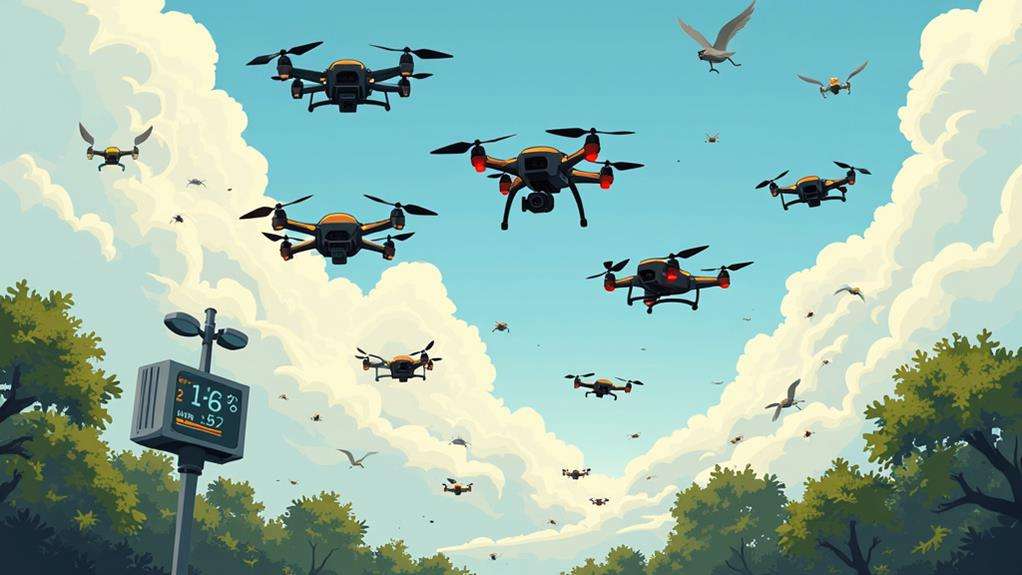
Why do some drones handle wind better than others? Several factors influence a drone's wind resistance and overall stability during flight. Understanding these elements can help you select the best drone for breezy conditions.
- Size and Weight: Larger and heavier drones generally offer better wind resistance due to their increased inertia, making them more stable in gusty conditions.
- Aerodynamic Design: Streamlined shapes reduce drag and improve airflow efficiency, directly enhancing a drone's wind resistance.
- High-Performance Motors: These motors provide the necessary thrust to counteract wind forces, helping the drone maintain stability even in challenging environments.
- Thrust-to-Weight Ratio: A higher thrust-to-weight ratio allows the drone to better resist wind interference, offering more reliable control and stability.
- Wind Resistance Rating: Wind resistance ratings range from 0 to 12, with Level 5 indicating the ability to handle wind speeds of 19-24 mph (30-38 km/h). Understanding these ratings can help you gauge a drone's performance in windy conditions.
Flying in Windy Conditions
When flying in windy conditions, it is crucial to accurately assess wind speed to ensure safe operation. Utilize both local weather reports and personal observations for the most reliable data. Employ stabilization techniques to maintain control and conserve battery life in challenging gusts.
Assess Wind Speed
Flying your drone in windy conditions requires a careful assessment of wind speed to ensure safety and stability. Understanding your drone's wind resistance is crucial. Most consumer drones can handle wind speeds up to 10-15 m/s (22-34 mph), but always verify your specific model's maximum wind speed rating to avoid crashes.
To accurately assess wind speed, follow these steps:
- Check real-time conditions: Use an anemometer or a reliable weather app to get current wind speeds. Be aware that wind gusts can exceed sustained speeds.
- Evaluate your drone's stability: Even if your drone has a high wind resistance rating, strong winds can still affect its stability.
- Monitor battery levels closely: Flying in windy conditions requires constant adjustments, which can drain your battery faster.
- Choose your flying location wisely: Open areas are more prone to strong winds. Opt for sheltered spots if conditions are marginal.
- Know your limits: Beginners should avoid flying in winds above 10-15 mph, while experienced pilots might manage up to 20 mph with caution.
Stabilization Techniques
To ensure safe and controlled drone flights, especially in windy conditions, it is crucial to employ effective stabilization techniques. Begin by taking off and landing directly into the wind, which enhances stability and minimizes lateral movement during these critical phases. Utilize position hold or automated landing features to maintain stability and allow for precise control without constant manual adjustments.
During landing, maintain a low approach angle of around 20% pitch to counteract sudden gusts and ensure a smoother descent. When departing, fly against the wind to facilitate a more controlled return, enhancing both stability and speed.
Regularly recalibrate the drone's sensors and stabilization systems before flights in high wind conditions. This step significantly improves performance and control, helping the drone handle sudden gusts and maintain stability. By adopting these stabilization techniques, you can confidently fly your drone in challenging windy conditions, ensuring safety and precision in your aerial operations.
Best Practices for Safety
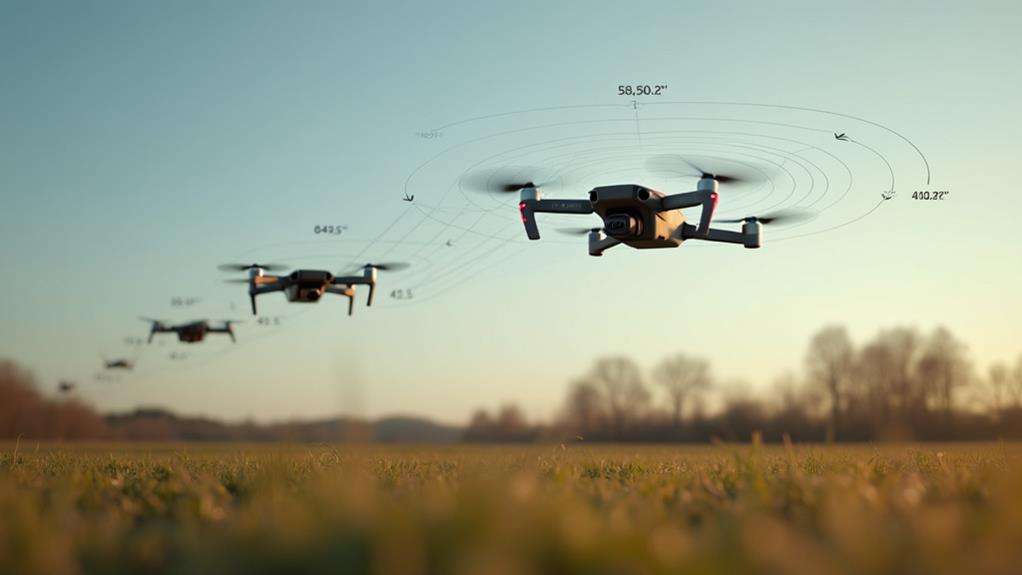
Ensuring your drone's safety in windy conditions requires a proactive approach to monitoring wind forecasts from reliable sources. As a drone operator, it's crucial to recognize that wind speeds above 10-15 mph can significantly affect your drone's control and stability. Understanding your drone's wind resistance capabilities—usually up to 20 mph for consumer models—is essential to avoid accidents.
Before flying, always check wind forecasts to determine if conditions are suitable. If you encounter strong gusts during flight, use the return-to-home function to prioritize safety over mission completion. For takeoff and landing, position your drone to face directly into the wind to enhance stability and minimize lateral drift caused by gusts.
Here are some best practices to follow:
- Monitor wind forecasts: Always check reliable sources before flying.
- Face into the wind: During takeoff and landing for better control.
- Know your drone's limits: Adhere to its maximum wind resistance level.
- Use return-to-home: If conditions worsen or stability is compromised.
- Practice on calm days: Familiarize yourself with handling your drone in various conditions.
Future of Wind Ratings
As drone technology advances, the future of wind ratings promises more precise and reliable metrics for pilots. Enhanced wind resistance ratings will help you make better-informed decisions about flying conditions. AI and machine learning could be integrated to allow for real-time adjustments based on changing environmental conditions, significantly enhancing flight safety.
Future regulations may require manufacturers to standardize wind resistance ratings through comprehensive testing protocols, improving transparency and making it easier for you to compare different consumer drones. With advancements in aerodynamic designs and lightweight materials, drones will likely achieve higher wind resistance capabilities, expanding their operational thresholds.
As the drone industry evolves, superior wind resistance ratings will become a key market differentiator, significantly influencing your purchasing decisions. Manufacturers will strive to develop drones with enhanced wind resistance, offering greater reliability and performance in various weather conditions. Overall, advancements in wind ratings will not only improve flight safety but also provide you with more versatile and capable consumer drones.

